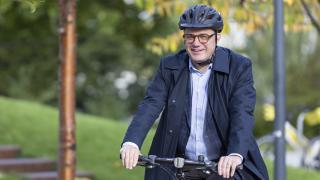What is the story of Vantaa, Mayor Pekka Timonen?
Interview with Mayor Pekka Timonen.

In Vantaa, two stories run in parallel. The oldest signs of settlement are from 5,000 BCE. In the 1200s, Swedish settlers came here and called the region Nyland, the new land. In the 1300s, the parish village of Helsinga was formed and the administrative parish was established in the 1400s. The oldest surviving buildings are the Church of St Lawrence from the 1400s, and the Håkansböle Manor and Königsberg Manor from the 1500s.
The second story of Vantaa is the story of how rapid urbanisation, triggered by the growing Helsinki Metropolitan Area, created the city of today. From the 1960s to the 1980s, Vantaa’s population rose from 42,000 to 130,000, and in the 1970s, the share of the urban population in Finland exceeded that of the rural population. And next year, we will celebrate this great change!
What should every resident of Vantaa know about their city?
A good starting point is understanding the long history of the region, characterised by the city’s good location. Vantaa has long been a place that people have passed through on their travels along the mediaeval King’s Road. Vantaa has always been a place that serves travellers: Tikkurila was one of the first seven train stations in our country.
Why has Vantaa grown so fast?
The development of the city has been rapid due to the urbanisation of Finland and the development of transport. This development has also been successfully utilised here. We have diverse housing opportunities, a well-functioning business structure, international expertise and a working-age population, as well as jobs.
What does the long time span of urban development mean?
The development of a city always involves current issues that need to be solved quickly, sometimes on the same day. Meanwhile, the time spans of long-term plans, such as city and traffic planning, already extend into the 2030s and 2040s. It is good to understand the long trajectory of urban development: sometimes there are positive periods and sometimes the development is laborious. At the moment, we do not yet know how the changes taking place in the world will be reflected in Vantaa. Being aware of our history teaches us to think about time, how things can have several time spans and how things can sometimes happen independent of us.
Does Vantaa have to change?
No, if the world stopped changing. However, the world keeps changing, so the City of Vantaa also needs to be capable of change. This means that we need to find the solutions with which we can strengthen ourselves further and stay on the path that leads us forward. Innovations created in Vantaa are an excellent example of this: the new inventions are answers to the need to find new ways to adapt to change. The city brings together different people, creating a community that can do more together than anyone can do alone.
How will the internationalisation of Vantaa affect urban development?
Already almost 25% of our population is international, so we need to dare to do things in a new way. Together, Vantaa and Espoo have approximately the same number of foreign-language speakers as Helsinki. This means that the Helsinki Metropolitan Area must come together to show the rest of the country how integration works. We want to be model cities of integration.
Internationalism and multilingualism are present in the whole city. In that sense, too, Vantaa
is just an ordinary European city. Vantaa is a good home for many kinds of Vantaa residents! Our exceptionally young population is important for urban development, as, for example, a large number of companies are being founded by young people, many of whom are our international professionals.
What are Vantaa’s trump cards?
Location, a working-age and international population as well as jobs. I am confident that Vantaa will continue to develop as an area of employment. Vantaa has a so-called half-hour guarantee: you can get here in half an hour from all the different corners of the Helsinki Metropolitan Area. And once the Vantaa tram starts running, our accessibility will improve even more! In addition to our urban elements, we are also nature-oriented and have the diverse housing opportunities I mentioned earlier. When a city grows rapidly, people sometimes need to wait for the services they need but, most of the time, the development of areas and the provision of services go hand in hand.
What would you like to say to the citizens of Vantaa?
I hope that each of us treats our families, neighbours, fellow people and surroundings in such a way that makes Vantaa even safer. I hope that Vantaa is known for how its residents make it a good place to live! What can you do to make everyone feel good in Vantaa?
This article was published in Residents' magazine 4/2023. Read the other articles on the resident magazine home page!




